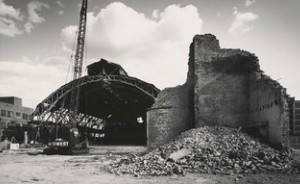
By Dan Lempa, Class of 2009
The last event held at the Chicago Coliseum, a James Taylor and Carole King concert, was on March 12, 1971. The next day the City of Chicago, citing code violations, shuttered the building for good. Few people born after the early 1950s probably have any idea of the significance of this building.
In 1889, Charles Gunther, a candy manufacturer, purchased the Libby Prison, a Civil War structure in Richmond, Virginia, had it dismantled, and shipped the 600,000 marked stones to Chicago at a cost of $200,000. He envisioned a Libby Prison Civil War Museum in Chicago. That endeavor at 1513 S. Wabash lasted about 10 years and was not very successful. In 1899, he demolished the warehouse-like structure, leaving only the front castellated wall. Behind it, he built the third Chicago Coliseum, a huge indoor arena. (Two previous Chicago Coliseums had existed, the first opened in about 1865; its demolition date is unknown. The second opened in 1896 and was consumed by fire after only 19 months.)

Over the next 70 plus years, the Chicago Coliseum hosted many events, including five consecutive Republican National Conventions from 1904 to 1920 where several U.S. presidents were nominated. Sporting events, trade and livestock shows, vaudeville and musical programs and rock concerts all found a home at the Coliseum. The first Auto Show was held there in 1901. Roller Derby, invented in Chicago, was held at the Coliseum. It was the first home to the Chicago Blackhawks as the Chicago Stadium was not built until 1928.

Other Chicago teams that played at the Coliseum will challenge Chicago sports trivia buffs. Remember the Chicago Cardinals—not the football team but the AHA hockey team? Or the Chicago Shamrocks, also an AHA hockey team? Many might remember the Chicago Packers, the name later changed to the Zephyrs, an NBA team that is still in business as the Washington Wizards. That was before the Chicago Bulls came in as an NBA expansion team in 1967. The Bulls played several times at the Coliseum when the circus made its annual appearance at the Chicago Stadium.
There was also a dark side to the Coliseum. It was the site of the famous 1st Ward Ball, sponsored by Hinky Dink Kenna and Bathhouse John Coughlin. At the 1908 ball, the Everleigh sisters, as the Masters of Ceremony, led the midnight Grand March. This several day event evolved into an out-of-control brawl, described in the papers as an evening of debauchery and an orgy of vice catering to the gamblers, pimps, prostitutes, and pickpockets along with the police and politicians.
Ten years after its closing, my family’s company, Midwest Wrecking, was awarded the contract for demolition. The total contract was $122,000. The application for demolition permits was delayed until the Commission on Chicago Landmarks reviewed the building. The commission voted to not seek landmark status.
In 1982 the Coliseum was a sad place, with a 20-foot hole in the roof of the Main Hall and most of the seating long gone. Huge buildings in that condition are dark, cavernous, and depressing. Demolition began in April 1982.
I grew up in the wrecking business, often accompanying my dad on weekends as he supervised urban renewal projects that cleared the way for expressways, housing projects, IIT, and UIC. During the 1950s I witnessed a whole block of buildings pushed over shoved into a pile near the center of the block and lit on fire. Open burning of demolition debris was legal! The Chicago Fire Department would be notified and often sent a truck to observe; the firemen would sit there, drinking coffee and making sure nothing got out of hand.

The picture above was taken on the second day of the Coliseum project. The building was made up of three separate halls, and we were just starting on the South Hall. The center hall in the above picture was 300 feet long along Wabash Avenue, by 170 feet deep to the alley. The alley was simply too tight to fit a crane, end loader, and trucks for hauling the demolition debris, so we worked off the street.
An interesting feature was that of the giant trusses spanning the largest of the three arenas from east to west. They were constructed in two sections, intended to swivel in place, locking into a single, huge truss.
I’ve often walked in a building just before the wrecking ball swung and wondered about the history and people who occupied or labored there. The Coliseum was a place that more than a bit of history was made in.


Dan, What a wonderful chronology of a building many of our younger docents may not even remember. Thanks for remembering all those sports teams — frankly, I didn’t remember most of them. You sure can tell a wonderful party.
Great story Dan! Thank you for this building and family history. Well done.
Fascinating, Dan! I missed the Carol King concert and the Hinky Dink bash, but am pretty sure I attended a sporting event or two there back in the day..
Hi Dan,
Great story of a legendary Chicago icon..
Midwest Wrecking holds a cool, alternative point of view on Preservation.
Thank you.
Dan, great article…I only really “saw” it from the Red Line in the early 80″s as I was commuting to UC. I knew it was special but did not have this info in my head. I, too, wondered all the stories that took place in there. JP
Great article, Dan.